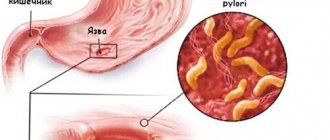Cottage cheese is a product that has proven itself in nutrition for a variety of diseases. It is included in most therapeutic and preventive diets and has a wide range of beneficial qualities. However, the answer to the question of whether it is possible to use it for gastritis is far from clear-cut.
How it works in the body
Due to the content of important nutritional components, cottage cheese performs several functions at once:
- Supplies calcium and phosphorus necessary for building bone tissue, normal functioning of the nervous system and muscles, and regulating blood clotting processes.
- It is a source of protein containing essential amino acids that cannot be obtained from plant foods. Protein from cottage cheese is absorbed and processed more easily than from meat or fish.
- Contains a large amount of vitamins (A, E, P, B) and minerals (magnesium, iron, fluorine).
- Reduces cholesterol thanks to methionine in its composition.
- Populates the digestive tract with probiotic cultures necessary to normalize digestive processes.
- Moderately increases the production of gastric juice, which improves food digestion.
Experiments have shown that cottage cheese produces several times less hydrochloric acid than whole and fermented milk.
This is what makes it possible to use cottage cheese in dietary nutrition for diseases of the gastrointestinal tract. However, sometimes the high nutritional value of a product can be harmful. For example, its excessive consumption significantly increases the load on the kidneys due to the high concentration of protein.
Option with carrots
The dish made according to this recipe has a delicate structure and a light, pleasant aroma. It is ideal for a morning meal and will saturate the body with all useful vitamins and minerals. This means that it can be included in the diet for gastritis. The casserole consists of inexpensive and easily digestible ingredients, which should include:
- 300 grams of cottage cheese.
- Egg.
- 100 grams of carrots.
- 100 milliliters of milk.
- 40 grams of sugar.
- 30 g semolina.
- 10 grams of butter.
- Vanillin.
Place peeled and grated carrots in a saucepan. Milk and butter are also added there. All this is simmered over low heat until the vegetable is soft, and then lightly mashed with a fork. The resulting carrot puree is combined with pureed cottage cheese, semolina, sugar, egg and vanillin. Mix everything well and transfer to a heat-resistant container. Cook the dish at standard temperature for half an hour.
Use for different types of gastritis
Acute gastritis in any form is a contraindication for cottage cheese. You can eat it only when the symptoms of the disease subside and your health improves. At this time, cottage cheese should be eaten in crushed, paste form, heat-treated before consumption and choose a low-fat product.
- If you have hyperacid gastritis with high production of hydrochloric acid, you cannot eat cottage cheese in its raw form - it can further increase the acidity.
- In the hypoacid version, raw cottage cheese is allowed, but it must first be ground in a blender or purchased ready-made curd pastes.
- Erosive gastritis also requires a gentle diet so as not to provoke a deepening of the defect in the stomach wall. Therefore, the curd must also be crushed before use. Preference should be given to low-fat varieties. It is allowed to consume both raw and thermally processed products.
- Atrophic gastritis is characterized by thinning of the gastric mucosa, so that it cannot fully produce gastric juice. Therefore, fresh cottage cheese is not contraindicated in this case, but only in the form of a paste, since large curd grains can injure the fragile mucous membrane.
What combinations are useful?
Heat-treated carrots, beets, pumpkin, and zucchini can be safely combined with cottage cheese.
They are also added to casseroles and curd soufflés. You need to be careful with raw vegetables, as they are more difficult to digest, stimulate the peristalsis of the gastrointestinal tract, and a sore stomach requires a gentle regime.
You can safely add fruits and berries to the curd mass, such as pears, apples, bananas, pineapples, watermelons, cherries. All fruits must be ripe. You must first peel the skins of pears and apples. It is better to add heat-treated apples.
For hyperacid gastritis, choose sweet varieties of apples; for hypoacid gastritis, you can eat more sour varieties. Fruits such as melon, grapes, kiwi, and citrus fruits are prohibited.
You can also season the cottage cheese with low-fat sour cream, unsweetened yogurt without additives, herbs, dried fruits, candied fruits, a small amount of nuts (walnuts, pine nuts, almonds, hazelnuts), and seaweed. It is also advisable to chop dried fruits and nuts before use. People suffering from gastritis with low acidity can afford to eat cottage cheese with cocoa, since it also slightly increases the secretion of hydrochloric acid.
What to cook
Dishes made from cottage cheese are characterized by great variety and excellent taste, of course, if you cook them with soul.
Syrniki
Boil 1 cup of rice until half cooked, add 250 g of crushed curd mass, 3 eggs, 50 g of sugar, a pinch of salt. Mix all the ingredients thoroughly, form them into flat cakes and put them in the oven. Cook cheesecakes at 180 degrees until golden brown.
Casserole
To 400 g of grated cottage cheese add 50 g of soft butter, 2 grated boiled carrots, 2 eggs, 30 g of sugar, a pinch of salt. Mix all the ingredients into a homogeneous mass, place in a mold and bake for about half an hour at 180 degrees.
Souffle
Mix 300 g of curd paste, 2 bananas mashed with a fork, 2 eggs, 1 tablespoon of semolina, 50 g of sugar. We put the mixture in the mold, put it in a steam bath and bring it to readiness.
You can add permitted vegetables, fruits, and minced meat to casseroles and soufflés.
A portion of raw cottage cheese should be 150-200 g per day every day . Restrictions on heat-treated cottage cheese are not so strict. In the absence of serious kidney disease, you can eat it, focusing on your well-being.
The time of day when you are allowed to eat curd products largely depends on your lifestyle and the chosen recipe. More nutritious dishes with the addition of meat and vegetables are best eaten in the first half of the day, when digestion processes are more active. You can eat cottage cheese for breakfast if you have a busy day at work and there is no opportunity to be distracted by snacks.
If you eat often enough, you can have a “cottage cheese” lunch at 10-11 a.m. or an afternoon snack at 4-5 p.m. In the evening, it is better to eat low-fat cottage cheese without calorie additives, no later than 3 hours before going to bed.
Option with semolina
Using the technology described below, you can prepare a delicious and healthy curd dessert without much hassle. It consists of simple ingredients, which means it is ideal for dietary nutrition. With a minimum of time and effort, you can prepare a flavorful casserole. When you have gastritis, you have to give up many foods, so this recipe will allow you to diversify your meager menu at least a little. To prepare this dessert you will need:
- 200 grams of cottage cheese.
- Egg.
- 50 grams of sour cream.
- A tablespoon of melted butter, sugar and semolina.
That's all the simple set you need to create a delicious casserole. For gastritis, the quality and freshness of the products used play an important role. Therefore, when going to the store, be sure to pay attention to this important aspect.
In one bowl combine pureed cottage cheese, egg, semolina and sugar. Mix everything well until smooth. The resulting mass is placed in a heat-resistant container, greased with sour cream and put in the oven. Prepare a dietary dessert at two hundred degrees for half an hour.
How to choose
There are several important points that need to be assessed when choosing cottage cheese:
- Best before date. If the period is indicated for more than 5 days, it means that the composition contains a preservative, and this is not the most useful substance for gastritis.
- Sealing of packaging. The packaging must be intact and not swollen.
- Storage conditions. According to SanPin, cottage cheese can be stored in a store for no more than 12 hours in the absence of cold and no more than 36 hours at a temperature of 8 degrees and below. Unfortunately, we cannot always reliably find out how much a particular pack of cottage cheese is in the store. An open pack of cottage cheese can be stored in the refrigerator for 2 days at a temperature of 5-6 degrees, or 4 days at a temperature of 1-2 degrees
- Smell. This can be done by purchasing cottage cheese wrapped in wax paper. The smell should be typically “cottage cheese”, slightly sour, without fragrances.
- Consistency. It is also realistic to evaluate only in paper packaging. Both soft and too hard contents are equally suspicious.
- Fat content. For gastritis, it is better to choose low-fat varieties of cottage cheese or those with low fat content - from 2% and below.
Note! When it comes to low-fat cottage cheese, then, according to Russian standards, its fat content should still be more than 1% for complete absorption of all nutrients. If the fat content is less than 1%, then such cottage cheese does not contain enough protein, and calcium is most likely present in it only as an additive.
A little about curd “delicacies”
Today you can see a wide range of cottage cheese products on grocery store shelves, but they often bear little resemblance to cottage cheese as such. Let's figure out which of these products a person with gastritis can safely eat.
Cheesecakes
It is important to carefully read the label and find out the exact name of the product. If it is “curd cheese”, then you can safely buy it, but it is better to refrain from purchasing a “curd product” - you will not find natural ingredients in it. A patient with gastritis should not eat flavored or glazed cheeses. Even natural chocolate for gastritis must be limited, and even more so confectionery icing, which has nothing to do with chocolate.
Cheeses
It is allowed to eat low-fat curd cheeses, without spicy additives and hot spices, which can irritate the sensitive mucous membrane of the stomach. Curd cheese with a dense consistency must also be crushed before use.
Vareniki
Buying ready-made dumplings in supermarkets is not a good idea. They contain a lot of unnecessary additives that the stomach can react to, and the amount of dough clearly prevails over the filling. But the dough is their most harmful component; it is too difficult to digest. Therefore, you can eat dumplings only during a period of stable remission and no more than 2 times a week. It’s better to cook them yourself and give preference to lazy dumplings. If you still want to try the classic version, then instead of water you need to add whey to the dough to reduce the load on the stomach.
Pies
Also acceptable for gastritis during remission, but not semi-finished products, but reliable home-cooked products. The most dietary option is baked pies made from wheat and oat flour with non-sour cottage cheese. Under no circumstances should you fry them; the stomach always reacts negatively to fried food.
Cakes
People with gastritis should avoid such sweets. Even if the cottage cheese itself in the cake does not cause harm, the other components are quite capable of this. In any case, the cake requires the presence of some kind of cream, an abundance of carbohydrates and fats. Even the most dietary cake has nothing to do with a diet for gastritis. It’s better to treat yourself to cottage cheese casserole or pies.
Proper preparation
Low-fat cottage cheese or homemade fermented milk product are most suitable for preparation. Before kneading the dough, rub the cottage cheese through a fine sieve. It is recommended to knead the dough very thoroughly to prevent the formation of lumps, and also beat it additionally with a blender.
The approximate baking time is individual, since the softening of the fruits or vegetables included in the composition, as well as the baking of the dough, is influenced by the degree of heating and the characteristics of ovens and steamers.
The casserole must be served only when it has cooled , since hot foods are prohibited for gastritis. To improve the digestion process, it is recommended to add one or two tablespoons of low-fat yogurt or sour cream to the prepared dish.









